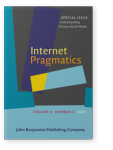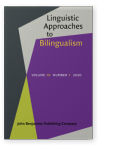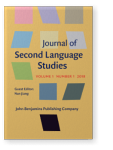Min Wang
List of John Benjamins publications for which Min Wang plays a role.
2021 More than playfulness: Emojis in the comments of a WeChat official account Understanding Chinese Social Media, Zhao, Sumin and Chaoqun Xie (eds.), pp. 247–271 | Article
This study aims to uncover the complexity of emoji usage on Chinese social media. We investigate emoji usage in comments on push notifications from the WeChat official account of Guokr, which was chosen as a representative for an open forum for public communication. The data includes 2,552… read more
2020 The influence of the native language on phonological preparation in spoken word production in a second language Linguistic Approaches to Bilingualism 10:1, pp. 109–151 | Article
Three experiments investigated the phonological preparation unit in planning English spoken words, comparing English monolinguals, native Chinese and Japanese-speakers who spoke English as their second language. All three groups named pictures in English, and the names could either share the same… read more
2018 Chapter 20. Neural mechanisms of reading in Korean L1 and related L2 reading Writing Systems, Reading Processes, and Cross-Linguistic Influences: Reflections from the Chinese, Japanese and Korean Languages, Pae, Hye K. (ed.), pp. 411–426 | Chapter
Korean has a unique status compared to other alphabetic orthographies in terms of its phonology-orthography mapping and visual-orthographic configuration. In this chapter we reviewed recent literature on the neural bases of reading in Korean L1 to understand whether and how the characteristics of… read more
2018 The use of lexical and sublexical cues in speech segmentation by second language learners of English Journal of Second Language Studies 1:1, pp. 166–198 | Article
This study examined the use of lexical and sublexical cues in speech segmentation by Mandarin L2 learners of English, focusing on two types of lexical cue, lexical knowledge and semantic relatedness, and three coda (sublexical) cues, /n, s, ŋ/ due to their varying phonotactic probabilities in… read more
2018 Chapter 2. Introduction to script processing in Chinese and cognitive consequences for bilingual reading Writing Systems, Reading Processes, and Cross-Linguistic Influences: Reflections from the Chinese, Japanese and Korean Languages, Pae, Hye K. (ed.), pp. 25–48 | Chapter
The Chinese writing system forms the sharpest contrast with the English writing system in terms of its grapheme-phoneme mapping principle. This review paper begins with a description of the characteristics of the Chinese writing and spoken systems, which is followed by the discussion of… read more
2018 Chapter 17. Crosslinguistic influences of script format: L1-derived syllabification in reading L2 English among native Korean readers Writing Systems, Reading Processes, and Cross-Linguistic Influences: Reflections from the Chinese, Japanese and Korean Languages, Pae, Hye K. (ed.), pp. 353–372 | Chapter
This study investigated cross-linguistic influences of the Korean script’s syllabic format on L2 English word reading. A total of 103 college students participated in two naming experiments in Korea and the U.S. Experiment 1 used Korean graphemes presented in both block (i.e., Hangul printing… read more



